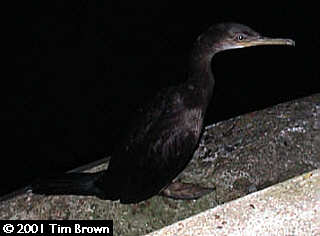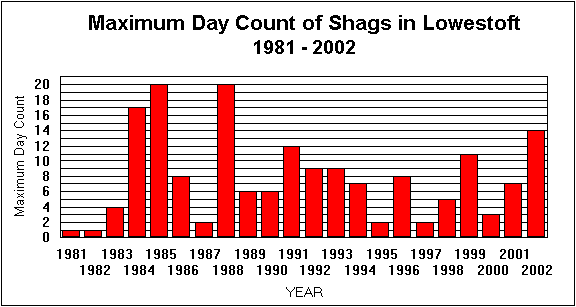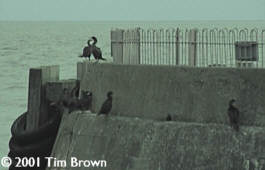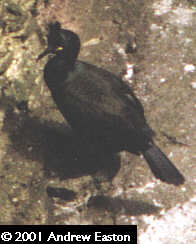|
|
STATUS OF SHAGS
IN LOWESTOFT
by Andrew Easton
 Lowestoft has always been one of the best places, in East Anglia,
to see Shags Phalacrocorax aristotelis during the winter.
The sheltered waters along Lake Lothing provide good feeding opportunities,
with Lowestoft Harbour offering easy access to roosting ledges. Ipswich
Docks are another favoured site in Suffolk, presumably for similar
reasons.
Lowestoft has always been one of the best places, in East Anglia,
to see Shags Phalacrocorax aristotelis during the winter.
The sheltered waters along Lake Lothing provide good feeding opportunities,
with Lowestoft Harbour offering easy access to roosting ledges. Ipswich
Docks are another favoured site in Suffolk, presumably for similar
reasons.
The sandy sea bed close inshore between Great Yarmouth and Kessingland results in limited visibility so few diving birds feed there. Instead Divers, Cormorants, and probably some Shags seem to prefer the deeper water beyond the sandbank where shallow water turbulence is less of a hindrance to their feeding. This is also why divers are usually so frustrating to see locally, good numbers can be seen in flight just beyond the sand bank but once they settle on the sea they become impossible to see in the swell.
Fortunately many Shags take advantage of the clearer waters of Lake Lothing, though the wintering population fluctuates considerably from year to year. This variation is illustrated in the chart below. This shows the maximum day count in each year over the last two decades. They have been recorded every year, and in every month of the year, with the peak count of 20 occurring in 1985 and 1988. The peak count nearly always occurs in the winter and the great majority are first winter birds. Birds often stay into the month of May and in some years one of two over-summer.

 The
maximum count so far in 2002 is fourteen. During the day the best place
to find them is at the western end of Lake Lothing, between Leathes Ham
and Oulton Broad. The bridge that crosses the railway line near Leathes
Ham provides a good vantage point to scan. Later in the afternoon they make
their way towards the harbour where they roost. Most birds tend to fly the
final stretch rather than swim all the way, some just skimming the water,
though others will fly in at rooftop height.
The
maximum count so far in 2002 is fourteen. During the day the best place
to find them is at the western end of Lake Lothing, between Leathes Ham
and Oulton Broad. The bridge that crosses the railway line near Leathes
Ham provides a good vantage point to scan. Later in the afternoon they make
their way towards the harbour where they roost. Most birds tend to fly the
final stretch rather than swim all the way, some just skimming the water,
though others will fly in at rooftop height.
As in most winters all are first year birds. This may account for their inexperience at landing. Watching their efforts to get onto the small ledge on the end of the South Pier is quite amusing. Their antics include long circuits of the harbour complex. When their approach is aborted at the last moment they often end up sliding down the wall into the sea. Eventually they all make it and settle down for the night as the image intensified grab to the left shows. In previous winters they have roosted on the Kittiwake wall, which is deserted in the winter, but in the late spring as the Kittiwakes return to reclaim their nests fights between the two species regularly break out. These squabbles often result in the Shags being pushed, or sometimes dragged, off the wall.
Shags
are considered to be relatively sedentary. Adults generally move up to 100
kilometres and juveniles 200 kilometres from their breeding grounds. Although
the nearest colonies to Lowestoft are located at Flamborough Head in North
Yorkshire, the handful of ringed birds seen in our area indicate that some
birds that reach Lowestoft originate from colonies much farther afield along
the east coast of the UK. This species is prone to being displaced great
distances, the result either of gales or the poor feeding conditions that
may result from such adverse weather.
 In early 1977 an adult bearing a colour ring present in Lowestoft Harbour
proved to have been ringed as a nestling on the Farne Islands in 1970. In
1994 one found dead at Hopton in January had been ringed on the Isle of
May, Fife, Scotland on 2nd August 1991, a distance of 500 kilometres. In
February and March 1999 three colour ringed first winters all from the Isle
of May were in the harbour. In April and May 2000 another Isle of May colour
ringed bird was in town, and more surprisingly it returned in March 2001.
This bird was believed to be the first individual from that colony to have
returned to a previous wintering site so far south from its natal site.
It had previously been assumed that birds displaced so far south usually
died, the use of colour rings which, are much easier to read on living birds
than standard metal rings may help to prove this assumption wrong.
In early 1977 an adult bearing a colour ring present in Lowestoft Harbour
proved to have been ringed as a nestling on the Farne Islands in 1970. In
1994 one found dead at Hopton in January had been ringed on the Isle of
May, Fife, Scotland on 2nd August 1991, a distance of 500 kilometres. In
February and March 1999 three colour ringed first winters all from the Isle
of May were in the harbour. In April and May 2000 another Isle of May colour
ringed bird was in town, and more surprisingly it returned in March 2001.
This bird was believed to be the first individual from that colony to have
returned to a previous wintering site so far south from its natal site.
It had previously been assumed that birds displaced so far south usually
died, the use of colour rings which, are much easier to read on living birds
than standard metal rings may help to prove this assumption wrong.
Thanks to Rob Wilton
for help with this article, and Tim Brown for the accompanying videograbs.
References:
Lack, P. The Atlas of Wintering Birds in Britain and Ireland.
1986. T & AD Poyser.
The Suffolk Bird Report 1981-1999